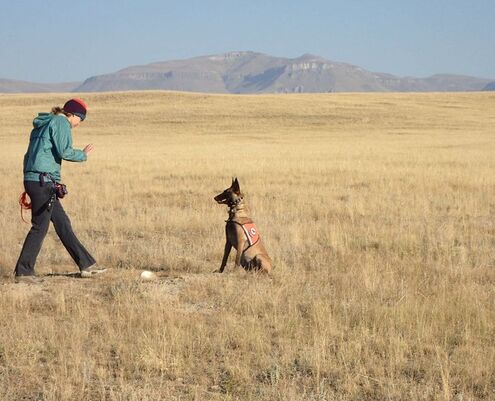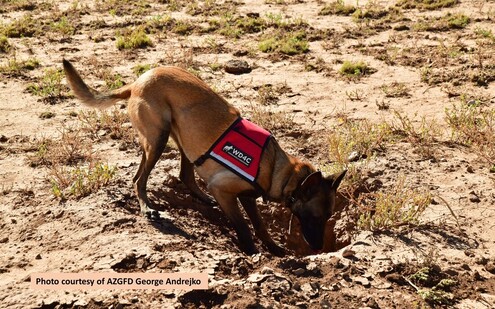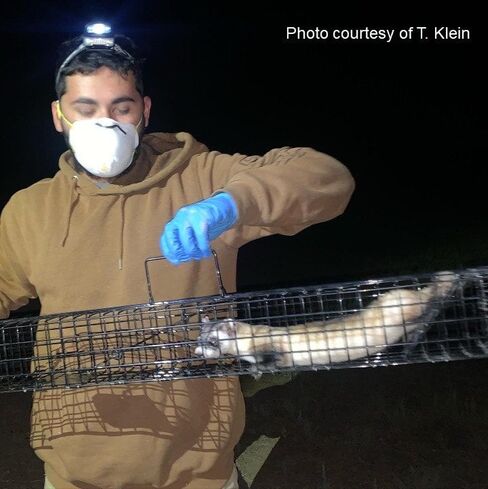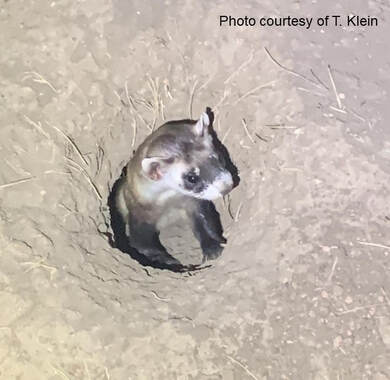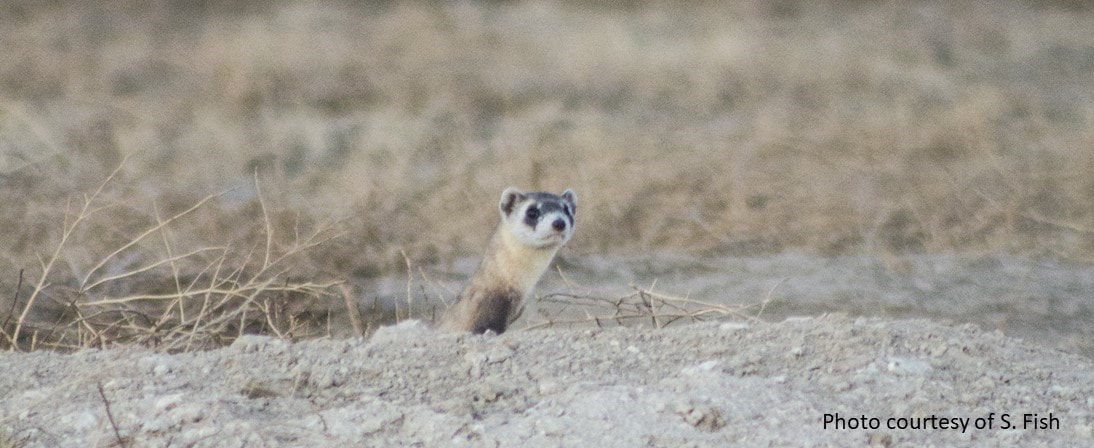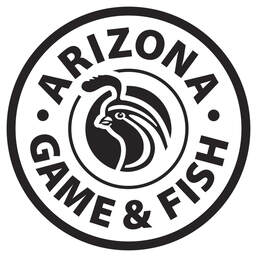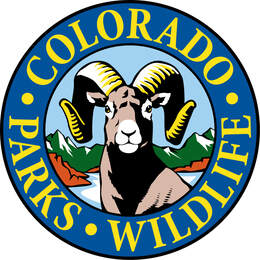Recovery of Black-Footed Ferrets
Wildlife Ecology Institute has been leading and partnering
on several projects focused on recovery of this endangered species
Here's a snapshot of the following:
Wildlife Ecology Institute has been leading and partnering
on several projects focused on recovery of this endangered species
Here's a snapshot of the following:
- Using Scent-Detection Dogs for Locating and Monitoring Black-Footed Ferrets (multiple projects)
- Additional Tools for Plague Management and Ferret Recovery
- Black-Footed Ferret Information Repository (BFFIR)
Using Scent-Detection Dogs for Locating and Monitoring Black-Footed Ferrets:
Creating a Powerful New Tool For Ferret Conservation Across their Range
Creating a Powerful New Tool For Ferret Conservation Across their Range
The continued recovery of the federally endangered black-footed ferret (Mustela nigripes), a species once thought to be extinct, is dependent on timely and appropriate management to mitigate the many challenges this species faces today. These management actions inherently rely on the efficacy of survey techniques for this semi-fossorial, nocturnal, and elusive mustelid. Although spotlight surveys are considered to be the most effective means for monitoring ferrets, this technique does have its limitations (e.g., limited spatial and temporal scale, low detection rates, difficult to conduct). Ferret managers are in need of effective alternative or supplemental techniques as recovery continues and the need for efficient use of limited resources increases. Thus, evaluating novel survey techniques that can enhance monitoring for ferrets will benefit recovery and conservation efforts for this species.
Professionally trained scent-detection dogs have been used to survey a wide variety of difficult-to-detect species and have initially shown potential as an effective tool for detecting ferrets. During 2017-2018, renewed efforts to evaluate this technique occurred in Wyoming, and provided evidence that scent-detection dogs could locate individual ferrets and identify areas of high use by ferrets. While the Meeteetse results were encouraging, conclusive evaluation of dogs as a tool requires real-time monitoring of ferrets moving across a natural landscape.
We are partnering with state, tribal, and federal agencies, and other NGOs, to fully assess and fine tune the use of scent-detection dogs for locating and monitoring black-footed ferrets.
Professionally trained scent-detection dogs have been used to survey a wide variety of difficult-to-detect species and have initially shown potential as an effective tool for detecting ferrets. During 2017-2018, renewed efforts to evaluate this technique occurred in Wyoming, and provided evidence that scent-detection dogs could locate individual ferrets and identify areas of high use by ferrets. While the Meeteetse results were encouraging, conclusive evaluation of dogs as a tool requires real-time monitoring of ferrets moving across a natural landscape.
We are partnering with state, tribal, and federal agencies, and other NGOs, to fully assess and fine tune the use of scent-detection dogs for locating and monitoring black-footed ferrets.
|
Arizona (2019)
Double O Ranch, Northern AZ Through a collaborative effort with Working Dogs for Conservation, Arizona Game and Fish Department, and the U. S. Fish and Wildlife Service, we developed a project in Arizona that capitalized on real-time location data from radiomarked ferrets as part of the work conducted by the Arizona Game and Fish Department. Specifically, we assessed whether professionally trained scent-detection dogs could identify individual burrows that had currently or recently been occupied by a ferret. We trained detection dogs to perform an alert when the olfactory cues of a ferret were detected at burrow openings and used the dogs to conduct diurnal surveys of burrows within a colony of Gunnison prairie dogs (Cynomys gunnisoni) on the Double O Ranch in northern Arizona. We compared points of interest as identified by detection dogs during surveys to data that included underground locations of radiomarked ferrets. During data analyses, we quantified how detection probabilities change based on changes in study design (e.g., search effort, search area, transect spacing) and based on amount of time since a burrow was last known to be occupied by a ferret. Our results suggest that when surveys are carefully designed with consideration of spatial scale and the ability of trained dogs to detect olfactory cues that may remain underground after a source has left, detection dogs can be valuable to monitoring efforts for ferrets, and possibly other semi-fossorial species. Stay tuned for our published work. Montana (2021-2022) Fort Belknap Indian Reservation in Northcentral MT We conducted a field evaluation of the effectiveness of forward-looking infrared (FLIR) camera technology and professionally trained scent-detection dogs for detecting ferrets on black-tailed prairie dog (Cynomys ludovicianus) colonies on the Fort Belknap Reintroduction Site. Fort Belknap Indian Reservation is homeland to the Assiniboine (Nakoda) and Gros Ventre (Aaniiih) Tribes, and is located in northcentral Montana. We were part of a larger effort that included multiple project partners, including Fort Belknap Indian Community. Our results provided support of the usefulness of both FLIR cameras and professionally trained dogs as tools for detecting and monitoring ferret populations, but also that additional efforts will maximize their utility for ferret conservation. For example, we successfully detected ferrets using FLIR cameras mounted on the top of vehicles, but an evaluation of cameras mounted on stationary towers or unmanned aerial vehicles may yield additional benefits for ferret recovery. Similarly, dogs exhibited the capacity to detect ferrets in burrows during diurnal periods, but there were instances where we were unable to use secondary methods to validate dog alerts at burrows. We recommended continued efforts to include quantifying detection rates for ferrets by dogs and comparing dog alerts and changes of behavior at known ferret locations to further improve this survey technique. Colorado (2022-2023) Five Study Sites in Eastern CO Our study area includes five study sites in eastern Colorado, four of which currently have populations of black-footed ferrets) and one which does not to serve a control site. As we continue to assess the effectiveness of professionally trained dogs for detecting and monitoring reintroduced populations of the endangered black-footed ferret, this project is also designed to inform managers on the utility of dogs for monitoring ferret population within Colorado, while simultaneously improving the understanding of dog-based survey methods for ferrets throughout the range of the species. Our objectives include to directly compare detection rates of ferrets by dogs at reintroduction sites in Colorado to those derived from recent work in Arizona, Montana, and Wyoming; to evaluate the influence of seasonal variation in ferret activity and behavior (i.e., denning, kit emergence) on detection rate of ferrets by dogs; to measure and reduce the frequency of non-target detections (i.e., false-positives) of ferrets by dogs thereby improving overall dog effectiveness and evaluation metrics; and based on our results, optimize survey protocols for using dogs to detect ferrets in Colorado where conditions differ from previous locations and directly inform ongoing ferret monitoring efforts at reintroduction sites in Colorado. |
A black-footed ferret peers out from a prairie dog burrow in Aubrey Valley, Arizona. Photo Credit: Arizona Game and Fish Department.
Tule, a professionally trained scent-detection dog, alerts for detection of a black-footed ferret in a prairie dog burrow ferret in Meeteetse, Wyoming. Dog handler Melissa Steen, Working Dogs for Conservation, sends encouraging commands to the dog. Photo credit: Working Dogs for Conservation.
|
_______________________________________________________________________________________________________________________________________________
Additional Tools for Plague Management and Ferret Recovery
|
Our projects have also had other components, which typically relate to reviews and assessments.
The primary challenge to recovery efforts continues to be associated with the biological impacts of sylvatic plague, an exotic disease that devastates populations of ferrets and the prairie dogs they rely on for food and habitat. We completed a detailed review of the availability of facilities currently capable of testing field samples for sylvatic plague and we provided recommendations on how these processes may be improved to standardize and streamline sampling testing. Another tool in the toolbox for ferret recovery is a relatively new method called the burrow-activity survey. We evaluated the effectiveness of the burrow-activity survey for assessing the status of prairie dogs within black-footed ferret reintroduction sites. We specifically focused on how this method might be used to assess large-scale plague management actions in a statistically robust manner. |
_______________________________________________________________________________________________________________________________________________
|
Black-Footed Ferret Information Repository (BFFIR)
We developed and implemented the Black-footed Ferret Information Repository (BFFIR), which is an online database that is available to personnel actively involved in ferret recovery. At the time of implementation, December 2020, the BFFIR contained nearly 800 downloadable documents and had 55 active users representing a variety of state, tribal, and federal agencies, and non-profit organizations involved in ferret recovery. In addition, in collaboration with U.S. Fish and Wildlife Service (USFWS), we further expanded the BFFIR to include a point-and-click feature for users to complete a series of USFWS permitting requirements related to ferret recovery efforts and a thorough review process for ensuring the security of any sensitive information. The BFFIR is a valuable resource for ferret recovery and during early 2023, the BFFIR was transitioned to and now hosted by BlackFootedFerret.Org.
|
_______________________________________________________________________________________________________________________________________________
Project Partners
Copyright 2024 Wildlife Ecology Institute

